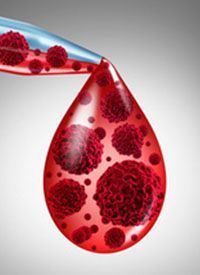Article
Survival is Significantly Poorer for Young Black Patients With AML Compared With White Counterparts
Author(s):
Despite receiving similar treatment, Black patients between the ages of 18 and 29 years with acute myeloid leukemia were twice as likely to die within 5 years compared with Whites.

Despite receiving similar treatment, Black patients between the ages of 18 and 29 years with acute myeloid leukemia (AML) were twice as likely to die within 5 years compared with Whites, according to newly published findings in Blood Advances.
Investigators added that Black patients in this age group were 5 times more likely to die within 30 days of receiving treatment, defined as early death, and survived just a median of 1.3 years compared with 10.2 years for White patients (P <.001; HR, 0.48; 95% CI, 0.28-0.81).
Investigators observed no significant differences in pretreatment clinical, demographic, or molecular characteristics between Black and White adolescent and young adult (AYA) patients who died early.
There were no such racial differences in survival among patients aged 30 to 39 years. The median overall survival (OS) was 2.2 years in both groups and 42% of patients in both groups were alive at 5 years.
There is an inverse relationship with age and survival for most cancers, including patients with AML. Furthermore, some cancer types have demonstrated a unique biology in AYA patients that can affect response to treatment, although this factor has not been adequately studied in AML.
Previous data have demonstrated racial differences in outcomes in AML. Black patients have shorter disease-free (DFS) and overall survival (OS) compared with age-matched White patients.
It is not known whether these survival disparities persist specifically in AYA patients, and whether AML has unique genetic characteristics in these patients.
Investigators at The Ohio State University Comprehensive Cancer Center–James, Duke University Medical Center, the University of Chicago, and others compared survival for 89 non-Hispanic Black patients vs 566 non-Hispanic White patients aged 18 to 39 years treated on frontline Cancer and Leukemia Group B/Alliance for Clinical Trials in Oncology protocols from 1983 to 2016. Samples from 50 Black and 277 White patients were analyzed via targeted sequencing, and investigators performed integrated genomic profiling on select longitudinal samples.
All patients received intensive induction treatment, followed by intensive consolidation
chemotherapy or autologous hematopoietic stem cell transplantation at first complete response (CR).
Age and sex distribution was nearly identical between Black and White patient groups. Investigators found no significant differences between clinical features at diagnosis.
Black patients aged 18 to 29 years had poorer outcomes across the board. Those patients had higher early death rates (16% vs 3%; P = .002), lower CR rate (66% vs 83%; P = .01), and decreased 5-year OS (22% vs 51%; P <.001) compared with White patients.
These disparities in survival persisted across cytogenetic groups. Forty percent of White patients were cytogenetically normal (CN) at diagnosis compared with just 19% of Black patients. Thirty-seven percent of Black patients had core-binding-factor(CBF)-AML compared with 22% of White patients. Black patients harbored t(8;21)(q22;q22)/RUNX1::RUNX1T1 twice as often as White patients (22% vs 10%; P = .002). The incidence of inv(16)(p13.1q22)/CBFB::MYH11 or t(16;16)(p13.1;q22)/CBFB::MYH11 was similar (15% vs 12%; P = .49). There were no significant differences in the frequency of recurrent cytogenetic abnormalities such as rearrangements of 11q23/KMT2A, t(6;9)(p23;q34), complex karyotype, or sole trisomy 8 between the 2 groups.
Black AYA patients with CBF AML had worse OS than White counterparts at 5 years (54% vs 70%; P <.05) and were more likely to experience early death (12% vs 3%; P = .06). Outcomes for younger Black AYA patients with non-CBF AML was “dramatically poorer” than that of White patients at 5 years for both DFS (14% vs 34%; P <.001) and OS (12% vs 44%; P <.001). Not a single Black patient with CN-AML aged 18 to 29 years was disease-free 5 years after diagnosis compared with 43% for White patients. Only 1 of 9 Black patients was alive at 5 years (13% vs 50%, P = .003).
Black patients aged 18 to 29 years with CBF-AML had better survival than Black patients with non-CBF-AML, but the survival of Black patients with CBF-AML was similar to that of White patients with non-CBF-AML.
Across the entire patient population, Black patients had worse outcomes than White patients including a higher early death rate (11% vs 2%; P <.001), a trend towards lower CR rate (73% vs 82%; P = .06), and poorer 5-year OS (32% vs 46%; P = .002). The median OS was twice as long in White patients (1.5 vs 3.1 years). Black patients had comparable 5-year DFS (32% vs 40%; P = .25) but median DFS was similar (1.2 vs 1.4 years).
Reference
- Larkin K, Nicolet D, Kelly BJ, et al. High early death rates, treatment resistance, and short survival of Black adolescents and young adults with AML. Blood Adv. Published online July 5, 2022. doi:10.1182/bloodadvances.2022007544









